Celebrate the Caribbean Endemic Bird Festival (CEBF) with us! Our theme in 2023 is “Water: Sustaining Bird Life” highlighting the importance of water conservation to both humans and birds. Have fun learning about a new endemic bird every day. We have colouring pages, puzzles, activities, and more. Download for free and enjoy nature with your family at home.
Endemic Bird of the Day: Gray-fronted Quail-Dove
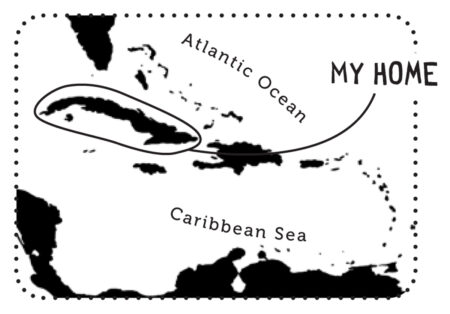 With patience and silence, you may be lucky enough to spot the stunning Gray-fronted Quail-Dove on the trail ahead or walking quietly in the nearby woods.
With patience and silence, you may be lucky enough to spot the stunning Gray-fronted Quail-Dove on the trail ahead or walking quietly in the nearby woods.
This Cuban endemic is usually found either at low elevations in wet forests bordering swamps, or at middle altitudes in dense moist woods. Here it forages in the leaf litter for seeds and small insects and is quite focused while searching for food. This is why if you remain still, it may not notice you and approach quite closely. This chunky dove walks with an unusual posture of chest down, head forward, and tail up.
The Gray-fronted Quail-Dove is easily spooked and once disturbed will quickly” melt back” into the forest! But it is a beautiful bird when seen in good light conditions. It is dark gray above with conspicuous purple and blue iridescence on its back, gray underparts with rufous lower belly, gray crown and neck, and white forehead. On the other hand, in poor light conditions it simply looks like a mid-sized, mostly dark pigeon.
If you can’t get a good look at it, listen out for its song, low-pitched repeated cooing notes, “uup-uup-uup-uup,” sometimes preceded by “oo-oo-oo-oo-oo.”
The breeding season is from January to August. Nests are built using twigs and leaves, lined with rootlets and/or grasses and placed 1–3 m above ground. Clutch size is 1–2 beige-coloured eggs. In captivity, incubation lasts 13 days and chicks fledge the nest in as little as 10-12 days.
The Gray-fronted Quail-Dove’s conservation status is listed as Vulnerable. It is generally uncommon and local, but it is known from ten localities in the Zapata region alone, and 45 localities in total.
This species faces a variety of threats from habitat loss, predation by introduced species, and hunting. Like the Blue-headed Quail-Dove, an even rarer Cuban endemic, it is a delicacy and consequently hunted using drop-traps baited with orange seeds. This rare dove would benefit from protection of its habitat from unsustainable development and introduced predators, and initiatives aimed at reducing its consumption. Learn more about this species, including its range, photos, and calls here.
Thanks to Aliya Hosein for the text!
Colour in the Gray-fronted Quail-Dove
Download our West Indies Endemic Bird colouring page. Use the photos below as your guide, or you can look up pictures of the bird online or in a bird field guide if you have one. Share your coloured-in page with us by posting it online and tagging us @BirdsCaribbean #CEBFfromthenest
Listen to the song of Gray-fronted Quail-Dove
The song of the Gray-fronted Quail-Dove is a continuous low-pitched “uup-uup-uup-uup”
Puzzle of the Day
Click on the image below to do the puzzle. You can make the puzzle as easy or as hard as you like – for example, 6, 8, or 12 pieces for young children, all the way up to 1,024 pieces for those that are up for a challenge!
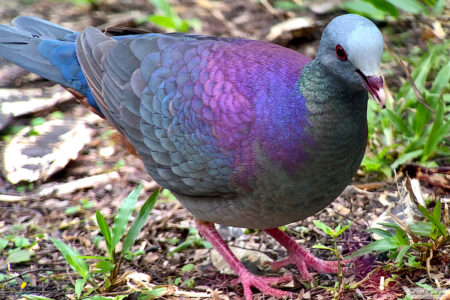
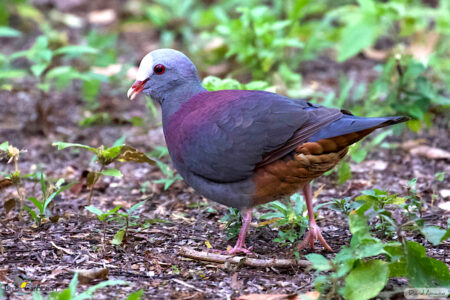
Activity of the Day
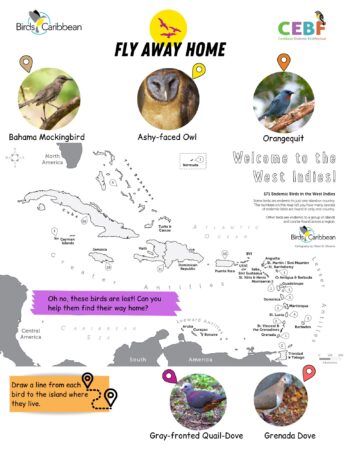 FOR KIDS: Test your knowledge of where Caribbean endemic birds live with our ‘Fly away home’ Map Matching Activity! Draw lines from the picture of each Caribbean endemic bird to match each one with its home. And here is the Answer Key – don’t look until you have completed the activity!!! You can find out more about Caribbean endemic birds by reading our posts each day or you can go back and find all the endemic birds that we have featured in previous years here. You can also find out all about our Endemic Birds of the West Indies Colouring Book with even more birds to colour in!
FOR KIDS: Test your knowledge of where Caribbean endemic birds live with our ‘Fly away home’ Map Matching Activity! Draw lines from the picture of each Caribbean endemic bird to match each one with its home. And here is the Answer Key – don’t look until you have completed the activity!!! You can find out more about Caribbean endemic birds by reading our posts each day or you can go back and find all the endemic birds that we have featured in previous years here. You can also find out all about our Endemic Birds of the West Indies Colouring Book with even more birds to colour in!
FOR KIDS AND ADULTS: Enjoy this video of this Gray-fronted Quail-Dove in the wild!
Seventeen strangers from three countries, Bahamas, Bermuda, and the United States, became fast friends on the BirdsCaribbean 4-day Pre-conference Tour, before the 2017 BirdsCaribbean meeting in Cuba. On a bird and culture packed tour the Gray-fronted Quail-Dove was just one of many endemic birds seen by the group. Read more about the trip in this blog post by Martha Cartwright.

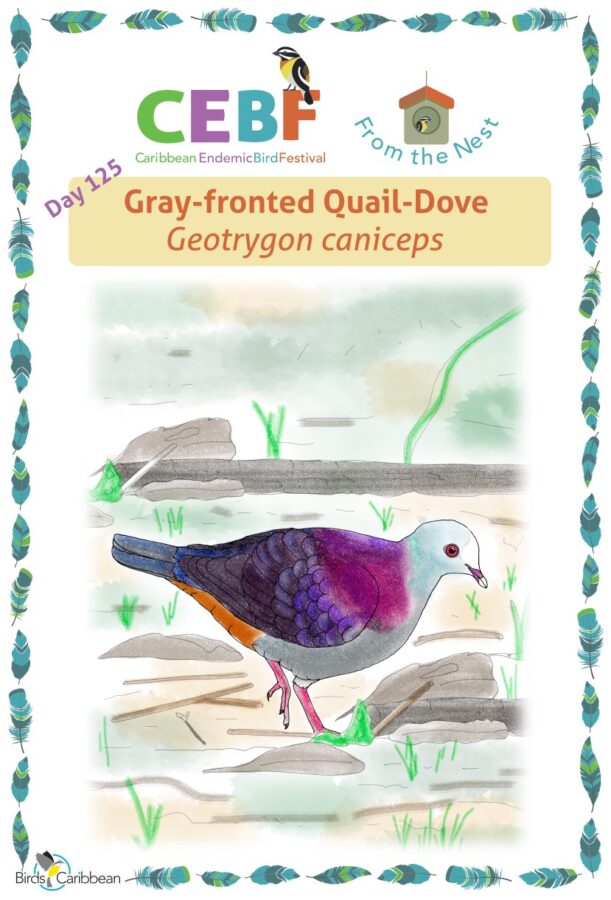
One comment
Comments are closed.